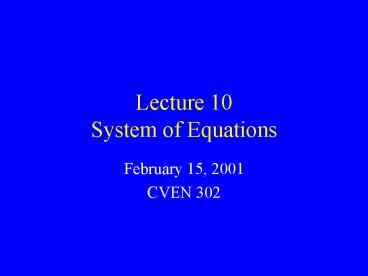Lecture 10 System of Equations - PowerPoint PPT Presentation
1 / 29
Title:
Lecture 10 System of Equations
Description:
Relaxation technique. Iterative Techniques ... SOR (Successive over Relaxation) uses the residuals to accelerate the convergence. ... – PowerPoint PPT presentation
Number of Views:78
Avg rating:3.0/5.0
Title: Lecture 10 System of Equations
1
Lecture 10 System of Equations
- February 15, 2001
- CVEN 302
2
Lectures Goals
- Iterative Techniques
- Jacobian method
- Gaus-Siedel method
- Relaxation technique
3
Iterative Techniques
- The method of solving simultaneous linear
algebraic equations using Gaussian Elimination.
Problems can arise from round-off errors and zero
on the diagonal. - One means of obtaining an approximate solution to
the equations is to use an educated guess.
4
Iterative Methods
- We will look at three iterative methods
- Jacobi Method
- Gauss-Seidel Method
- Successive over Relaxation (SOR)
5
Convergence Restrictions
- There are two conditions for the iterative method
to converge. - Necessary that 1 coefficient in each equation is
dominate. - The sufficient condition is that the diagonal is
dominate.
6
Jacobi Iteration
- If the diagonal is dominant, the matrix can be
rewritten in the following form
7
Jacobi Iteration
- The technique can be rewritten in a shorthand
fashion, where D is the diagonal, A is the
matrix without the diagonal and c is the
right-hand side of the equations.
8
Jacobi Iteration
- The technique solves for the entire set of x
values for each iteration. - The problem does not update the values until an
iteration is completed.
9
Example (Jacobi Iteration)
- 4X1 2X2 2
- 2X1 10X2 4X3 6
- 4X2 5X3 5
- Solution (X1 , X2 , X3 ) (0.41379, 0.17241,
0.86206)
10
Jacobi Example
- Formulation of the matrix
11
Jacobi Iteration
- Iteration 1 2 3 4 5 6 7
- X 1 0.5 0.2 0.45 0.324 0.429 0.376 0.42
- X 2 0.6 0.1 0.352 0.142 0.248 0.16 0.204
- X 3 1 0.52 0.92 0.718 0.886 0.802 0.872
12
Jacobi Program
- The computer program is setup to do the Jacobi
method for any size square matrix - Jacobi(A,b)
- The program can has options for maximum number of
iterations, nmax, and tolerance, tol. - Jacobi(A,b,nmax,tol)
13
Gauss-Seidel Iterations
- The Gauss-Seidel / Seidel technique is similar to
the Jacobi iteration technique with one
difference. - The method updates the results continuously. It
uses the new information from the previous
iteration to accelerate converge to a solution.
14
Gauss-Seidel Model
- The Gauss-Seidel Algorithm
- The combined vector is upgraded ever term.
15
Example (Gauss-Seidel Iteration)
- 4X1 2X2 2
- 2X1 10X2 4X3 6
- 4X2 5X3 5
- Solution (X1 , X2 , X3 ) (0.41379, 0.17241,
0.86206)
16
Gauss-Seidel Example
- Formulation of the matrix problem
17
Gauss-Seidel Iteration
- Iteration 1 2 3 4 5 6 7
- X 1 0.5 0.25 0.345 0.384 0.401 0.408 0.411
- X 2 0.5 0.31 0.231 0.197 0.183 0.177 0.175 X
3 0.6 0.75 0.815 0.842 0.854 0.858 0.858
18
Gauss-Seidel Model
- The computer program is setup to do the
Gauss-Seidel method for any size square matrix - Seidel(A,b)
- The program can has options for maximum number of
iterations, nmax, and tolerance, tol. - Seidel(A,b,nmax,tol)
19
Example - Iteration with no diagonal domination
- 3X1 - 3X2 5X3 4
- X1 2X2 - 6X3 3
- 2X1 - X2 3X3 1
- Solution (X1 , X2 , X3 ) (1.00, -2.00, -1.00)
20
Using the GS algorithm
- Using the Gauss-Seidel Program with the
following A matrix and b vector. - Solution (X1 , X2 , X3 ) (1.00, -2.00, -1.00)
21
Using a Gauss-Seidel Iteration
- Iteration 1 2 3 4 5 6
7 - X 1 1.33 2.283 3.425 2.057 2.765 1.474 2.023
- X 2 1.5 1.825 -0.243 -1.953 -5.622 -4.95 -7.91
5 - X 3 0.33 -0.16 -0.58 -2.031 -1.689 -3.384 -0.3
34
22
Successive over Relaxation
- The technique is a modification on the
Gauss-Seidel method with an additional parameter,
w, that may accelerate the convergence of the
iterations. - The weighting parameter, w, has two ranges 0 lt w
lt1, and 1lt w lt2. If w 1, then the problem is
the Gauss-Seidel technique.
23
SOR Method
- The SOR algorithm is defined as
- The difference is the weighting parameter, w.
24
The Weighting Parameter
- If the parameter, w is under 1, the residuals
will be under-relaxed. - If the parameter, w 1, the residuals are equal
to a Gauss-Seidel model. - If 1lt w lt 2 the residuals will be over-relaxed
and will general help accelerate the convergence
of the solution.
25
Example of SOR
- 4X1 2X2 2
- 2X1 10X2 4X3 6
- 4X2 5X3 5
- Solution (X1 , X2 , X3 ) (0.41379, 0.17241,
0.86206)
26
SOR Example
- Formulation of the SOR Algorithm
27
SOR Example
28
Effects of w Parameter
- Using the SOR program SOR(A,b,w,nmax,tol) with
nmax50 and tol 0.000001
29
Summary
- Convergence conditions need to be met in-order
for iterative techniques to converge - Jacobi method upgrades the values after each
iteration. - Gauss-Seidel upgrades continuously through
method. - SOR (Successive over Relaxation) uses the
residuals to accelerate the convergence.

